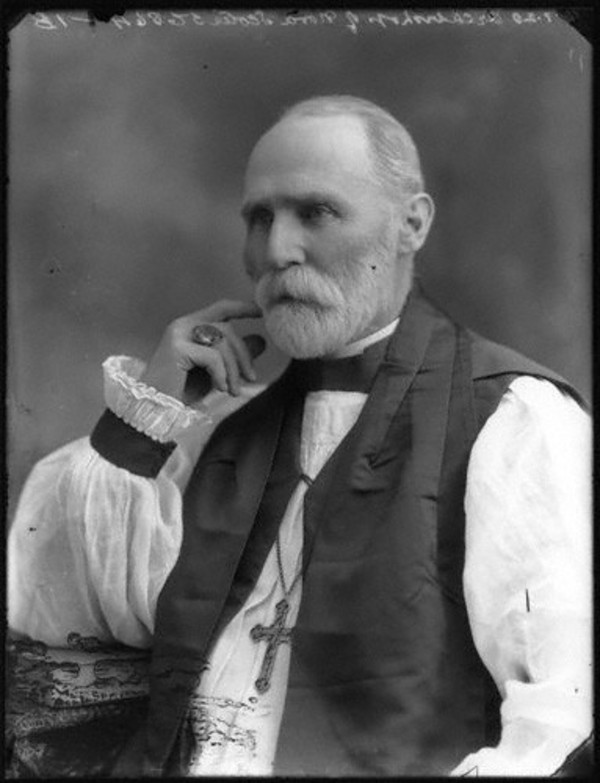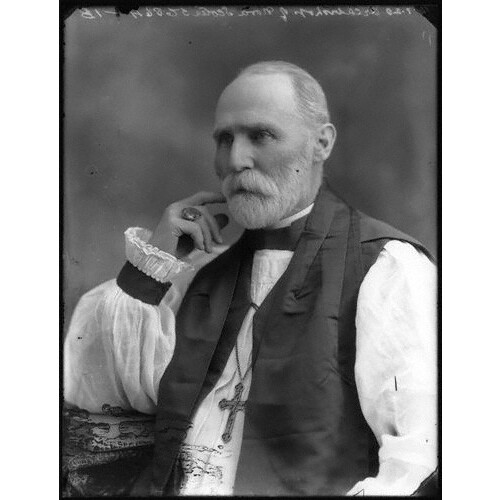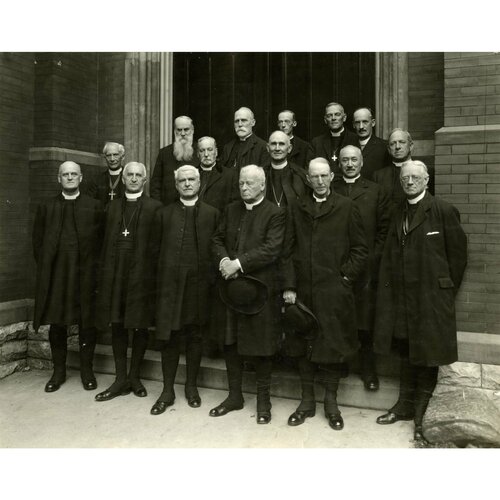
Source: Courtesy of Wikimedia Commons
WORRELL, CLARENDON LAMB, Church of England clergyman, educator, and archbishop; b. 20 July 1853 in Smiths Falls, Upper Canada, younger son of the Reverend John Bell Worrell and Elizabeth Jane Lamb; m. first 3 Jan. 1877 Charlotte Ann Ward (d. 23 Aug. 1915) in Stanhope, Que., and they had one son and three daughters; m. secondly 18 Oct. 1917 Annie Head Abbott in Halifax; they had no children; d. there 10 Aug. 1934.
Clare Worrell, as he was known, attended school in Smiths Falls, where his father was the Church of England rector, before entering Trinity College School, Port Hope, in 1870. His six months there and three years at Trinity College, Toronto, were marked by a number of academic awards. He received his ba with a first class in mathematics and a fourth class in classics in 1873. He would be awarded an ma from Trinity in 1883 and several honorary degrees later in his career.
Worrell considered following his brother, John Austin Worrell, into law. Instead he became a teacher, first as mathematics master at Bishop’s College School in Lennoxville (Sherbrooke), Que., and then at Hellmuth College in London, Ont., under Arthur Sweatman*; he later taught at Wentworth School in Hamilton and at Cobourg Collegiate Institute. By all accounts Worrell was a successful educator: “Quiet and firm as a disciplinarian, one with whom nobody would trifle or take a liberty,” was how Sweatman described him.
He returned to Trinity in 1878 to study divinity and was ordained deacon in 1881; he subsequently held the position of curate at Christ Church, Gananoque, and then at Holy Trinity Church, Brockville; he was also headmaster or principal of the local high schools. After being priested in 1884, Worrell served as rector of Williamsburg and Morrisburg, before being made professor of English literature at the Royal Military College of Canada in Kingston and rector of St Mark’s, Barriefield, in 1891. He would assume the rectorship of St Luke’s, Kingston, in 1903.
Clare Worrell’s rise to church leadership was marked by his appointment in 1896 as an examining chaplain to Archbishop John Travers Lewis* of Ontario and his nomination that year for bishop of Algoma, when he finished third on the ballot. In 1900 he was the preferred candidate of a large majority of the laity for coadjutor bishop of Ontario and missed being selected by one clerical vote [see William Lennox Mills*]. He was appointed archdeacon of Ontario in 1901 and elected prolocutor of the lower house of the synod of the ecclesiastical province of Canada three years later.
Worrell became sixth bishop of Nova Scotia following a contentious election in 1904 to replace Frederick Courtney, who had resigned to take up the rectorship of St James’ Church in New York City. After 11 ballots, the choice had fallen upon Henry John Cody*, rector of St Paul’s, Toronto, and a leading evangelical, who immediately declined. The synod then adjourned for two months after establishing a committee of laity and clergy to bring forward names to be considered. Worrell, a theological moderate, was proposed, along with the evangelical Lewis Norman Tucker, general secretary of the Missionary Society of the Church of England in Canada, and was elected after three further ballots on 31 August. His consecration took place in Christ Church Cathedral, Montreal, on 18 October.
Although not an outstanding preacher like his predecessor, Worrell had a commanding presence and brought energy, decisiveness, and administrative ability to the office. He recognized that he must immediately address the abysmal stipends received by most of his clergy and the needs of poorer parishes. In 1906 responsibility for financial support for parishes and clergy within the diocese, as well as missions elsewhere, was consolidated in the hands of a diocesan mission board, but monetary problems remained a preoccupation throughout Worrell’s episcopate.
So too did the situation at King’s College, Windsor. As the only Anglican college in the Maritimes, King’s was crucial for clerical formation. However, its tiny enrolment and poor financial condition made survival uncertain. Worrell tried to broaden the appeal of education at King’s for evangelicals, who looked with suspicion upon the predominance of high churchmen in the divinity school. This attempt met with only limited success, despite the bishop’s unceasing emphasis upon the need for tolerance between the high and low wings of the church.
Enrolment plummeted during World War I, and by 1918 there were only 39 students; fire destroyed the college’s main building two years later. In 1922 an endowment from the Carnegie Corporation of New York, offered in the hope of creating an academic federation in the Maritimes [see George Frederick Pearson] modelled on the University of Toronto, saved King’s from extinction. The condition was that King’s move to Halifax to associate with Dalhousie University. Worrell had long been a believer in university federation; the affiliation of King’s with Dalhousie, formed in 1923, remains one of his lasting accomplishments.
Perhaps the greatest achievement of Worrell’s episcopate was the completion of All Saints’ Cathedral in Halifax. This had been the dream of the fourth bishop, Hibbert Binney*, but plans had stalled after his death. The destruction by fire of St Luke’s Pro-Cathedral in December 1905 made action imperative, and Worrell committed himself totally to the project. Within a year he had arranged for the purchase of a site and hired the New York architectural firm of Cram, Goodhue, and Ferguson to design an imposing neo-Gothic structure. At the recommendation of Percy Erskine Nobbs* of McGill University, the American company’s proposals were chosen over those of local architect William Critchlow Harris*, though Harris was retained to superintend the project. Samuel Manners Brookfield* served as general contractor. Despite financial and construction difficulties, compounded by friction between the bishop and the architect, Bertram Grosvenor Goodhue, All Saints’ opened on 3 Sept. 1910 as the centrepiece of a Canadian church congress, presided over by Worrell, on the occasion of the bicentenary of the Church of England in Canada. That the building was completed on time owed much to the bishop’s force of will and determination.
He responded to World War I with fervent patriotism, seeing at issue not only the British empire but civilization itself. In his charge to the synod of Nova Scotia in 1917, he declared his support for the enfranchisement of women, in recognition of “their noble conduct and self-sacrificing effort for the good of humanity and support of the Empire.” The Halifax explosion on 6 December that year did significant damage to churches in both Halifax and Dartmouth, including his beloved cathedral. Attempts to obtain assistance for repairs from Anglicans elsewhere in Canada at a time when the country was exhausted by war had disappointing results. In 1919 Worrell was elected bishop of Bermuda, a diocese traditionally linked to Atlantic Canada, and he did not finally decline the position until 1924; in the interim, at the invitation of the archbishop of Canterbury, he acted as episcopal overseer and made two visits to the colony.
Worrell had been elected metropolitan of the ecclesiastical province of Canada in 1915, with the title of archbishop of Nova Scotia; he became acting primate of Canada in 1930, and in September the following year he was chosen primate. Eleven months later Canadian Anglicanism confronted the gravest financial crisis in its history when the church discovered that the endowments of the province of Rupert’s Land had been misappropriated by a leading Winnipeg lawyer, John Alexander Machray, who was also chancellor of the diocese of Rupert’s Land. The executive council of the General Synod was informed on 14 Sept. 1932 that the losses totalled approximately $759,000. Worrell responded, “The welfare and honour of the Church require that the work be maintained and that the lost endowments be replaced.” A campaign was launched to replace the endowments, and Worrell worked closely with its director, Canon Sydney Gould. Despite his advanced age, he tirelessly toured the country to rally support. By the time of his death in 1934 the endeavour was on the way to meeting its objective.
A prominent freemason, Worrell was also active in the Lord’s Day Alliance and served as Nova Scotia president of the Moral and Social Reform Council of Canada. He did not pretend to be a theologian, treating doctrinal issues with the same common sense that guided him as an administrator. In his eulogy at Worrell’s funeral, Bishop John Andrew Richardson of Fredericton observed, “His was a faith that was child-like in its simplicity, a devotion to duty that never faltered, an industry that never tired, a courage that was never dismayed.”
Anglican Church of Can., Diocese of N.S. and P.E.I. Arch. (Halifax), MG 1, ser.1, no.6 (Archbishop Clarendon Lamb Worrell papers); General Synod Arch. (Toronto), GS75-7A (Executive Council, General Synod), Minutes, 14 Sept. 1932; Restoration Fund, “Report,” 22 Sept. 1933. LAC, R233-37-6, Kingston, Ont., Ward C-2: 4. NSA, Churches, All Saints’ Cathedral (Halifax), RBMB, no.11401 (mfm.); MG 1, vol.2457 (H. B. Wainwright fonds), no.3; “Nova Scotia hist. vital statistics,” Halifax County, 1934: www.novascotiagenealogy.com (consulted 27 June 2013). Canadian Churchman (Toronto), 14 June 1900, 24 Sept. 1931, 19 Oct. 1933. Evening Mail (Halifax), 24 Aug. 1915. Globe, 8 Jan. 1877, 11 Aug. 1934. Halifax Herald, 11 Aug. 1934. Anglican Church of Can., Diocese of N.S., Year book (Halifax, 1903/4, 1906/7; copies at the Diocese of N.S. and P.E.I. Arch., C-1-2). Jim Blanchard, “The Machray scandal,” Manitoba Hist. (Winnipeg), no.33 (spring 1997): 27–37. Church of Eng. in Can., Diocese of Toronto, Synod, Journal, 1927; Eccl. Prov. of Can., Synod, Journal of the proc. (Hamilton, Ont.), 1920. Crockford’s clerical directory … (London), 1915. Leaders of the Canadian church, ed. W. B. Heeney (3 ser., Toronto, 1918–43), ser.3: 37–51, 87–116, 161–73. T. R. Millman and A. R. Kelley, Atlantic Canada to 1900: a history of the Anglican Church (Toronto, 1983). William Naftel, “An American in Halifax: Bertram Grosvenor Goodhue and the design and construction of All Saints Cathedral,” Royal N.S. Hist. Soc., Journal (Halifax), 9 (2006): 1–32. A Past Master of the Lodge [R. V. Harris], The history of Saint Andrew’s Lodge no.1, G. R. N. S., A. F. & A. M., 1750–1920 (Halifax, 1920). Henry Roper, “Evangelical–Tractarian conflict over divinity education at the University of King’s College,” Canadian Church Hist. Soc., Journal (Toronto), 36 (1994): 37–57. O. R. Rowley et al., The Anglican episcopate of Canada and Newfoundland (2v., Milwaukee, Wis., and Toronto, 1928–61). H. R. S. Ryan, Aspects of constitutional history: the General Synod of the Anglican Church of Canada (Toronto, 1993). D. M. Schurman, A bishop and his people: John Travers Lewis and the Anglican diocese of Ontario, 1862–1902 (Kingston, 1991). R. C. Tuck, Gothic dreams: the life and times of a Canadian architect, William Critchlow Harris, 1854–1913 (Toronto, 1978).
Cite This Article
Henry Roper, “WORRELL, CLARENDON LAMB,” in Dictionary of Canadian Biography, vol. 16, University of Toronto/Université Laval, 2003–, accessed December 18, 2025, https://www.biographi.ca/en/bio/worrell_clarendon_lamb_16E.html.
The citation above shows the format for footnotes and endnotes according to the Chicago manual of style (16th edition). Information to be used in other citation formats:
| Permalink: | https://www.biographi.ca/en/bio/worrell_clarendon_lamb_16E.html |
| Author of Article: | Henry Roper |
| Title of Article: | WORRELL, CLARENDON LAMB |
| Publication Name: | Dictionary of Canadian Biography, vol. 16 |
| Publisher: | University of Toronto/Université Laval |
| Year of publication: | 2015 |
| Year of revision: | 2015 |
| Access Date: | December 18, 2025 |




